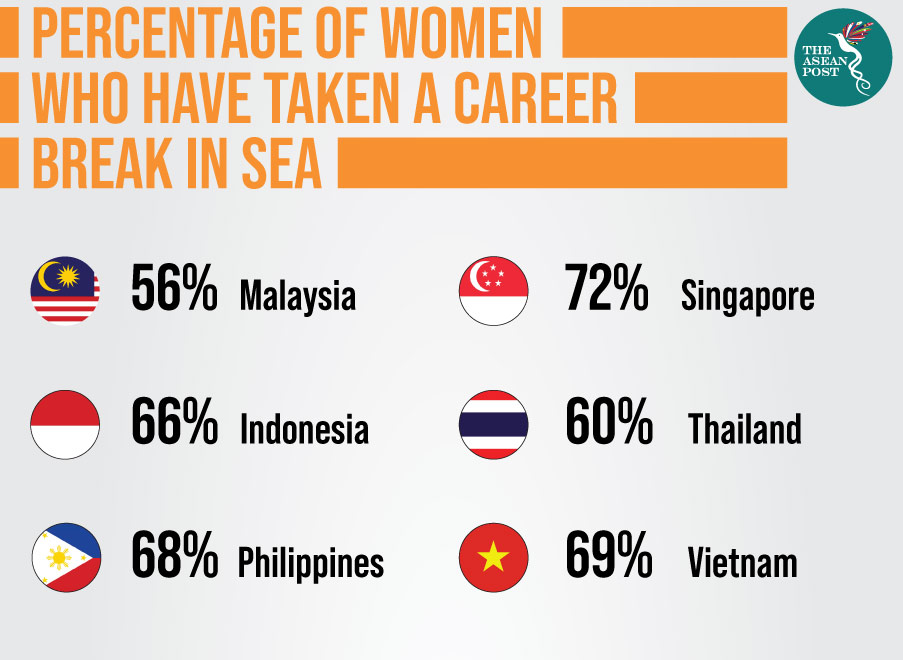There is a downward trend in the number of women participating in the workforce as they go up the career ladder. Women may make up half of all the entry-level positions in companies, but at middle management, that number drops. Towards the C-Suite level, only 15 percent of businesses globally have women in the CEO or managing director position, based on a 2019 Grant Thornton report, ‘Women in Business.’
The report revealed that females in senior management positions in the Philippines was at 47 percent in 2018, but women representation at the C-suite level dropped to a mere three percent, according to a 2018 report by McKinsey on ‘The Power of Parity: Advancing Women’s Equality in Asia Pacific – Focus: Philippines.’
In a 2017 report by a leading recruitment consultancy, Robert Walters, 65 percent of women in Asia have taken a career break at some point in their lives. The report, ‘Understanding employers’ attitudes towards women returning to work,’ revealed that more than half of the women in Southeast Asian countries such as Singapore, Vietnam, the Philippines, Indonesia, Thailand and Malaysia have taken career breaks.
Women stepping off the career ladder may account for the low number of women in top management positions.
Maternity leave and child-rearing
Women often take career breaks for maternity leave and child-rearing. But there are other reasons including caring for ageing parents and wanting to pursue higher education. Women also step off the career ladder to find a balance between increasing work responsibilities and home responsibilities. Some women leave the corporate world to start their own businesses to carve for themselves the workplace culture they want.
After a career break, many women struggle to return to work because childcare options are either limited or too expensive. Yet, 35 percent of professionals polled in the Robert Walters’ survey cited financial reasons as the top reason for deciding to re-join the workforce. The report also found that women return to work because of their desire to learn new skills (28 percent) and a lack of fulfilment when staying at home (18 percent).
Women who want to return to the job market do face difficulties. According to the Robert Walters’ report, 46 percent of hiring managers in Asia have not employed any returning women in the past year. The figure was highest in Malaysia (52 percent) followed by Singapore (49 percent). Employers have stated that they were unsure whether hiring returning women will benefit the workplace.

Other reasons companies are unwilling to hire more returning women are due to baseless perceptions that women are not up-to-date with latest industry trends and knowledge and that women are not as good at their jobs after they return from maternity leave because they would not be as committed, would be unwilling to stay late, or would request additional time off.
“The capability of women professionals is often questioned once they take maternity leave, or have significant lapses in their career trajectories,” said Joanne Chua, account director at Robert Walters Singapore.
There is a loss in the talent pool if women are not hired after they take career breaks and denying women’s right to return to work comes at an economic cost. Based on the McKinsey report, companies in the top quarter for gender diversity on their executive teams are 21 percent more likely to experience above-average profitability.
“Returning women often have vast experience and bring with them a certain maturity about their role. This talent pool can serve as a viable solution to the skills and gender gap prevalent in the workplace today. This is especially relevant for the technology sector, which faces severe skill shortages, but is underrepresented by women professionals,” said Sally Raj, Managing Director at Robert Walters Malaysia.
Career comeback
Fortunately, there is a growing number of companies and government initiatives that are offering ‘returnships’ or internship-like programs for women who wants to re-enter the workforce.
TalentCorp Malaysia, an agency under the Ministry of Human Resources (MOHR), initiated a ‘Career Comeback Program,’ in 2015 for professional women who wish to return to work after a career break. According to their data, 820 women in Malaysia have since returned to work through their program.
“I would definitely encourage women to come back to work. Not only because of the money but for the knowledge,” said Kala Govinathan of the Colgate-Palmolive Malaysia Career Comeback Programme.
Singapore’s Manpower Ministry offers grants to companies offering ‘returnship’ programmes to help women who took a career break, adjust back to the workforce. Singapore’s Career Navigators, a subsidiary of mums@work, are connecting firms with returning female talents. The service acts as a compass point for women who want to explore new (or restart) career paths whilst supporting them through training and actual job offers.
There are more companies now embracing flexible and family-friendly working environments, allowing parents to have a work-life balance. Offering longer paternity leave also supports women’s attachment to the workforce, whose increased participation will benefit the overall economy.
Getting rid of bias against women who take career breaks is also critical to ensure they are fully empowered when they re-enter the workforce.
Returning women represent a rich talent pool that can help to overcome skill shortages, increase diversity in the organisation and consequently provide measurable benefits such as decreased turnover rates and higher business gains. And women should not be made to choose between healthy ambition and child-rearing as they’re both rewarding.
Related articles:
Filipino women not moving up the ladder fast
